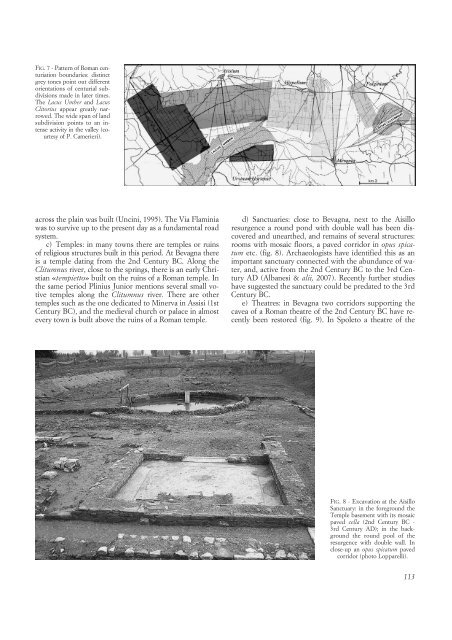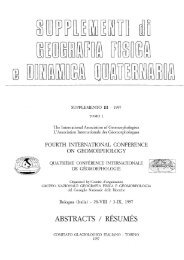Full Text (PDF)
Full Text (PDF)
Full Text (PDF)
Create successful ePaper yourself
Turn your PDF publications into a flip-book with our unique Google optimized e-Paper software.
FIG. 7 - Pattern of Roman centuriation<br />
boundaries: distinct<br />
grey tones point out different<br />
orientations of centurial subdivisions<br />
made in later times.<br />
The Lacus Umber and Lacus<br />
Clitorius appear greatly narrowed.<br />
The wide span of land<br />
subdivision points to an intense<br />
activity in the valley (courtesy<br />
of P. Camerieri).<br />
across the plain was built (Uncini, 1995). The Via Flaminia<br />
was to survive up to the present day as a fundamental road<br />
system.<br />
c) Temples: in many towns there are temples or ruins<br />
of religious structures built in this period. At Bevagna there<br />
is a temple dating from the 2nd Century BC. Along the<br />
Clitumnus river, close to the springs, there is an early Christian<br />
«tempietto» built on the ruins of a Roman temple. In<br />
the same period Plinius Junior mentions several small votive<br />
temples along the Clitumnus river. There are other<br />
temples such as the one dedicated to Minerva in Assisi (1st<br />
Century BC), and the medieval church or palace in almost<br />
every town is built above the ruins of a Roman temple.<br />
d) Sanctuaries: close to Bevagna, next to the Aisillo<br />
resurgence a round pond with double wall has been discovered<br />
and unearthed, and remains of several structures:<br />
rooms with mosaic floors, a paved corridor in opus spicatum<br />
etc. (fig. 8). Archaeologists have identified this as an<br />
important sanctuary connected with the abundance of water,<br />
and, active from the 2nd Century BC to the 3rd Century<br />
AD (Albanesi & alii, 2007). Recently further studies<br />
have suggested the sanctuary could be predated to the 3rd<br />
Century BC.<br />
e) Theatres: in Bevagna two corridors supporting the<br />
cavea of a Roman theatre of the 2nd Century BC have recently<br />
been restored (fig. 9). In Spoleto a theatre of the<br />
FIG. 8 - Excavation at the Aisillo<br />
Sanctuary: in the foreground the<br />
Temple basement with its mosaic<br />
paved cella (2nd Century BC -<br />
3rd Century AD); in the background<br />
the round pool of the<br />
resurgence with double wall. In<br />
close-up an opus spicatum paved<br />
corridor (photo Lopparelli).<br />
113















